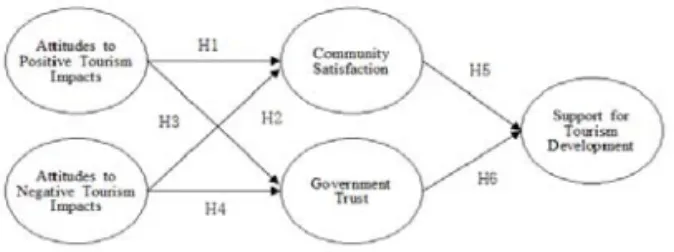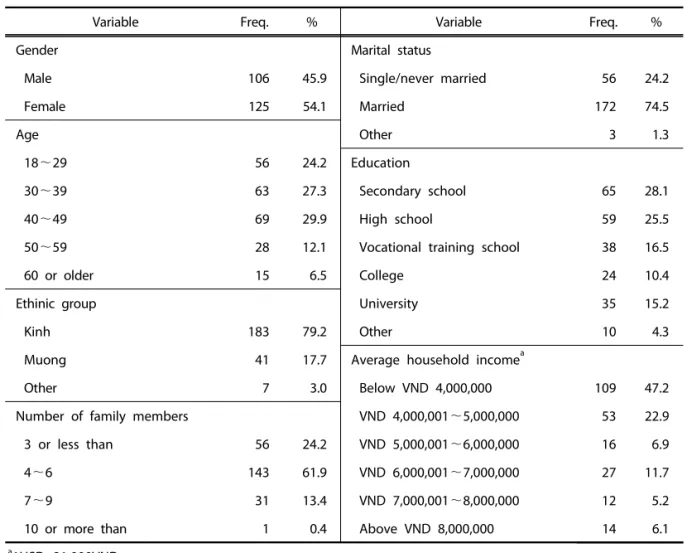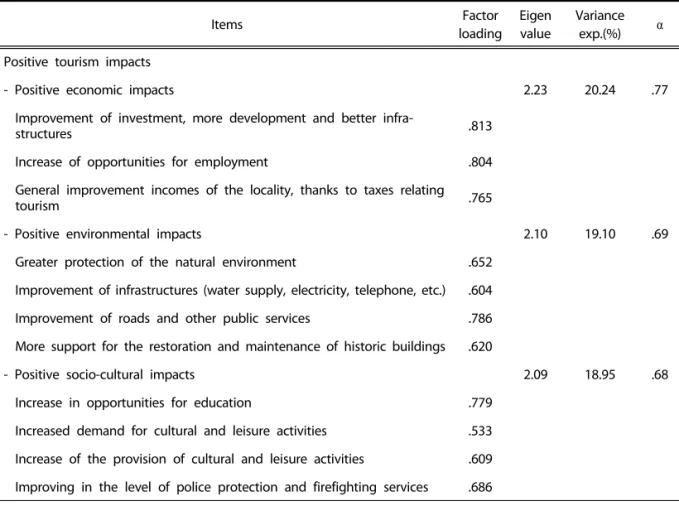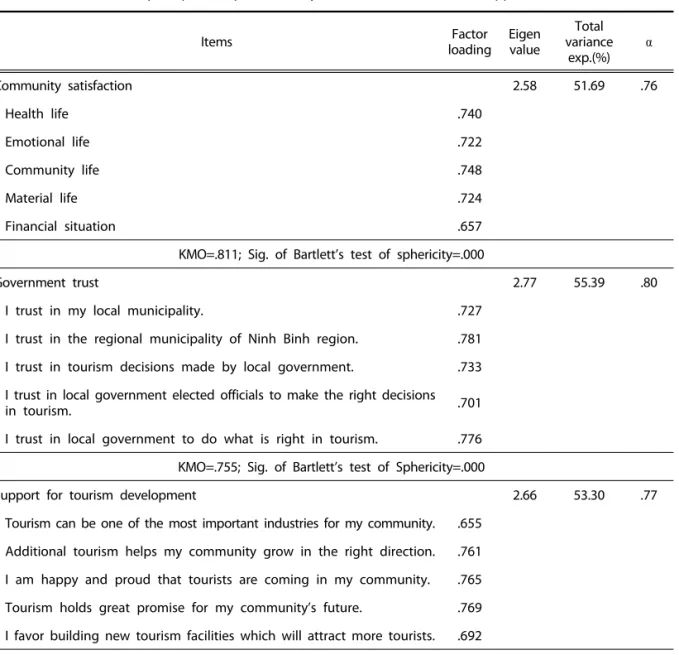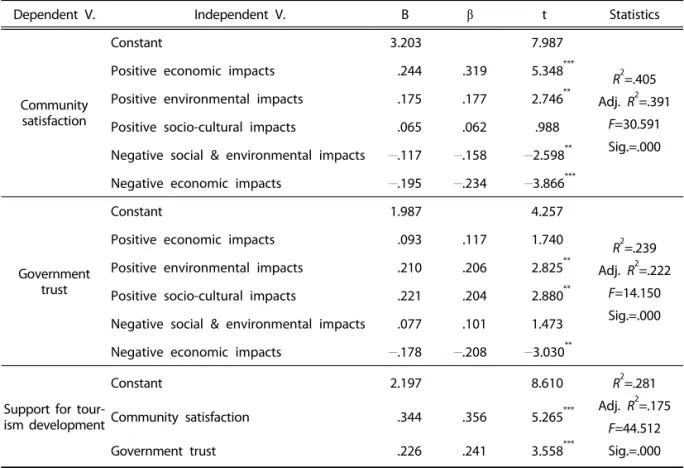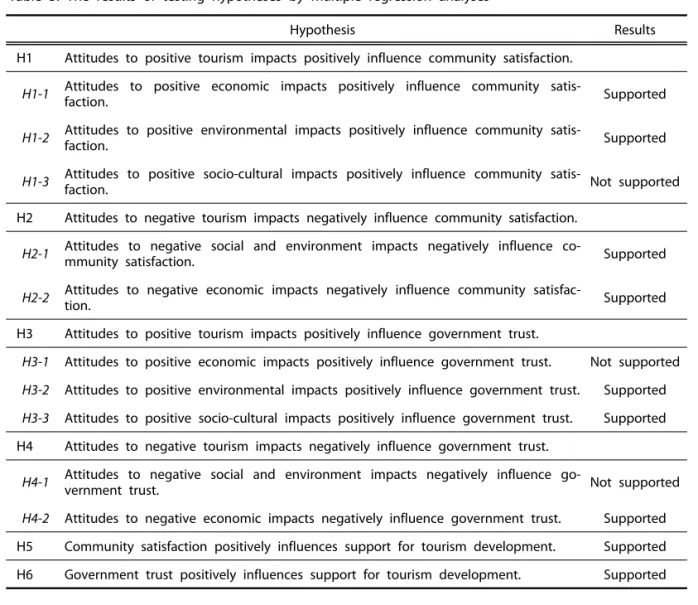¶ Corresponding Author: Hyun-Jung Kim, Assistant Professor, Dept. of Hotel & Tourism, Daegu University, Jillyang, Gyeongsan, Gyeongbuk 38453, Republic of Korea, Tel. +82-53-850-6144, Fax. +82-53-850-6149, E-mail: hkim@daegu.ac.kr
Culinary Science & Hospitality Research. 2016;22(1):96-107.
https://cshr.jams.or.kr/ ISSN 2466‐0752 (Print) ISSN 2466‐1023 (Online)
Achieving Local Residents’ Support for Tourism Development through Community Satisfaction and Government Trust
Trinh Thi Anh1 and Hyun-Jung Kim2¶
1Dept. of Tourism Management, Daegu University
2¶Dept. of Hotel & Tourism, Daegu University
ABSTRACT: The purposes of the study are (1) to explore relationships amongst attitudes to positive/ne- gative tourism impacts, community satisfaction, government trust, and support for tourism development and (2) to provide practical implications for policy makers how they can gain residents’ support by in- creasing community satisfaction and government trust, which are resulted from attitudes to tourism impacts. A questionnaire is self-administered to local residents using a systematic sampling method in Ninh Hai Commune, Hoa Lu District, Ninh Binh Province, Vietnam. The results indicate community satis- faction and government trust are core factors of support for tourism development. The study highlights that to attain community satisfaction and government trust, the policy makers should especially increase positive socio-cultural and environmental impacts and minimize negative economic impacts on the com- munity simultaneously.
Keywords: tourism impacts, satisfaction, trust, support, community, government
INTRODUCTION
Tourism development is widely viewed as a re- gional economic development strategy, especially in less developed countries[1,2]. The main goal of touri- sm development is to augment the positive impacts and diminish the negative impacts on the host com- munity[3]. It is important for planners to consider in- formation about the impacts of tourism from the lo- cal community’s perspective when planning for the industry and about the ways to increase residents' support for tourism development.
According to Andereck, Valentine, Knopf, and Vogt[4], residents’ support is based on their evalua- tions of the benefits and costs resulting from the industry. Residents are willing to enter an exchange with the industry if they believe that the gains are
higher than the costs. Accordingly, a community is likely to support tourism if the perceived positive impacts outweigh the negative consequences[5,6].
These positive and negative tourism impacts are closely related to residents' level of community sa- tisfaction[2]. Positively, tourism development gains benefits for community and improves local people quality of life; residents, therefore, feel satisfied with their community. Conversely, residents who evaluate tourism as costs of development are less satisfied with their community. Nunkoo & Ramkissoon[7] also highlighted that community satisfaction is an im- portant variable in understanding residents’ support.
In addition to community satisfaction, local resi- dents' trust in government is an important factor to enhance residents' support for tourism development [8] because tourism development is planned and im-
plemented mainly by local government in less de- veloped countries. The government manages to maintain a balance between economic priorities, en- vironment, and the local society in order to gain po- litical support for tourism development[9]. Institu- tions create policies and in exchange, they receive trust from citizens who are satisfied with these poli- cies and cynicism from dissatisfied residents. Thus, it is arguable that residents’ trust in government is predicted by the benefits and costs (that is, positive and negative tourism impacts) of tourism develop- ment[10].
In relationship marketing, satisfaction and trust are seen as essential ingredients for long-term rela- tionship and key predictors of customer loyalty[11, 12]. However, in tourism literature, scholars only tested the relationships between either community satisfaction or government trust with support for tourism development. However, this study insists that we combine and test the influences of com- munity satisfaction and government trust on resi- dents' support for tourism development and under- stand how tourism impacts affect community satis- faction and government trust in tourism develop- ment. Therefore, the purposes of the study are (1) to propose and test relationships amongst attitudes to positive/negative tourism impacts, community satisfaction, government trust, and support for touri- sm development, and (2) to provide practical im- plications for policy makers how they can gain resi- dents’ support based on the results of the study.
LITERATURE REVIEW
Attitudes to Positive and Negative Tourism Im- pacts
In the literature, tourism impacts are commonly divided into three types, which are economic im- pacts, social-cultural impacts, and environment im- pacts[13,14].
If local residents recognize positive economic im- pacts, their attitude toward nature-based tourism will be positive[15]. Tourism provides employment opportunities, increases incomes, develops local in- frastructures, etc. It also helps governments obtain tax revenues, foreign currencies, and diversifies the economy[16,17]. Nevertheless, tourism causes nega-
tive economic impacts. First, tourism causes inflation or unbalanced economic development[18] ; in- creases prices of goods, services, land and pro- perty[16]. More important, in the less developed countries, tourism development is usually depend- ent on foreign investor with more skills and money, and a few elites in the community. Thus, the income usually concentrates on these limited people that leads to the inequity of income distribution and in- crease poor people[19].
From a socio-cultural perspective, there are posi- tive and negative impacts of tourism. Pham[20] re- veals that tourism helps to broaden education, cul- tural horizons and improve feelings of self-worth; re- inforce preservation of heritage and tradition; pro- vide recreational facilities that may be used by local people; break down language barriers, socio-cultural barriers, class barriers, racial barriers, political bar- riers, and religious barriers. Tourism also promotes international understanding and peace[18]. Tourism fosters demand for local craftsmanship, new servi- ces, and better facilities, alternatives for leisure, and creates opportunities to exchange ideas and cultural knowledge[21,22,23]. Nonetheless, tourism develop- ment causes to negative impacts. According to Goeldner and Ritchie[18], the negative social and cultural impacts of tourism can occur to the host communities such as increasing crime, prostitution, and gambling; commercializing culture, religion, and the arts; contributing to disease and transportation problems; or threatening family structure.
Tourism development contributes positive envi- ronmental impacts like environment protection and conversation, but it can cause negative impacts like degradation to soil, water, and air pollution, forest devastation, etc. Because residents’ lives are affected by their surrounding environment, researching envi- ronmental impacts of tourism is important when studying tourism development[16]. Residents who suppose tourism will damage the environment are disapproving tourism development, while those who recognize tourism will preserve the natural environ- ment are approving[24].
Community Satisfaction
Community refers to a grouping of people sharing a general place within a particular geographically
called territory[25]. Satisfaction is defined as an emo- tion reaction elicited from service experiences[26]
and is one of the most important variable to under- stand one’s behavioral intentions[27,28,29,30]. Co- mmunity satisfaction involves not only perceptions of the service adequacy but also orientations of in- dividuals as to their places within the grouping, sa- tisfaction with locally based interactions, and a ge- neral perception of the quality of life in the locale [31]. Vargas-Sanchez, Plaza-Mejia, & Porras-Bueno’s [32] study reveals a direct correlation between resi- dents’ satisfaction with their community and per- ceived impacts. The study by Nunkoo and Ramkis- soon[23] which integrated community satisfaction as a determinant of residents’ attitudes also reveals the former to be a good predictor of community re- sponses to development.
Tourism gains benefits but causes costs on co- mmunities. As a result, it is likely that the benefits lead to local people’s satisfaction with community but the costs make negative impacts on their com- munity satisfaction. Ko and Stewart[2] indicate that a positive relationship exists between perceived po- sitive tourism impacts and overall community sa- tisfaction but perceived negative tourism impacts are negatively related to overall community satis- faction. Thus, this study deduces that positive tour- ism impacts are positively related to community sa- tisfaction and negative tourism impacts are neg- atively related to community satisfaction. The follow- ing hypotheses are, thus, developed:
H1: Attitudes to positive tourism impacts posi- tively influence community satisfaction.
H2: Attitudes to negative tourism impacts ne- gatively influence community satisfaction.
Government Trust
Trust is a ‘psychological state comprising the in- tention to accept vulnerability based upon positive expectations of the intentions or behavior of ano- ther’[33, p. 395]. Despite of the important roles of government in policy-making for sustainable tour- ism, research on political trust in the context of tour- ism development has remained virtually silent in the literature[10].
Social exchange theory posits that the benefits
and costs generating from a social exchange rela- tionship affect the trust of one actor on the other [34]. Government launches tourism policies that de- cide the level of tourism benefits and costs for local communities, and accordingly it gains trust from sat- isfied individuals with these policies and cynicism from dissatisfied ones[35].
Currently, the relationships between tourism im- pacts and government trust are controversial in the literature. Based on Nunkoo & Ramkissoon’s[10] stu- dy, there is a positive relationship between the per- ceived benefits of tourism and residents’ trust in government actors; and adversely, there is a nega- tive relationship between the perceived costs of tourism and residents’ trust in government actors.
Other studies demonstrate that benefits of tourism positively influence residents’ trust in government but costs of tourism do not significantly influence residents’ trust in government[17,36]. Despite the debates about the relationship between negative tourism impacts and government trust, this study suggests that attitudes to positive tourism impacts positively affect government trust but attitudes to negative tourism impacts negatively affect govern- ment trust. The reason for this suggestion is, for ex- ample, if government launches tourism policies that costs overwhelm benefits, in exchange, it leads to distrust from dissatisfied residents in government.
Thus, the following hypotheses are proposed:
H3: Attitudes to positive tourism impacts posi- tively influence government trust.
H4: Attitudes to negative tourism impacts ne- gatively influence government trust.
Support for Tourism Development
Support is an attitude by which a person orients himself to an object either favorably or unfavorably, positively or negatively[37]. Residents’ support for tourism development is examined as the ultimate dependent variable of the study and a pre-requisite for the sustainable development of the industry and without such support may hamper the industry’s growth and its future potentials in a destination[7].
It is important for a destination’s government to gain the community’s endorsement for tourism to ensure that the development process is socially
compatible.
There are controversial opinions of the relation- ship between community satisfaction and support for tourism development[2,7,32]. Despite the pre- vious results in the literature, this study supposes that community satisfaction has a positive influence on support for tourism development because when people feel satisfied with benefits from tourism to their community, they will support for tourism de- velopment. Hence, a hypothesis is developed as fol- lowing:
H5: Community satisfaction positively influences support for tourism development.
To achieve residents’ support for tourism develop- ment, the government should be trusted by local residents in a sense that the government looks after the interest of the community. Nunkoo and Ramkis- soon[10] and Nunkoo et al[8] find that residents’
trust in tourism institutions positively influences their level of support for tourism development. Addi- tionally, many researchers have validated the rela- tionship between government trust and political support for government policies[38,39]. Hence, this study hypothesizes that residents’ trust in govern- ment has a directly positive influence on their sup- port for tourism.
H6: Government trust positively influences sup- port for tourism development.
Figure 1 shows the conceptual model of the study.
METHODS
A self-administrated questionnaire was used to collect data. Participants’ attitudes to positive/nega- tive tourism impacts were measured by seventeen
Figure 1. The conceptual model.
items of positive tourism impacts and eleven items of negative tourism impacts adopted from Sirivong
& Tsuchiya[40], and Vargas-Sánchez et al[32]’s stu- dies. Participants’ level of community satisfaction was measured by six items adopted from Woo, Kim,
& Uysal[41]’s study. Participants’ government trust was measured by five items adopted from Nun- koo[36]’s study. Participants’ support for tourism de- velopment was measured by eight items adopted from McGehee & Andereck[42]’s study. All the items were rated on a 7 point Likert scale with moderate as a midpoint. Participants were also asked about their socio-demographic information namely gender, age, ethnic group, education, marital status, number of family members, and annual household inco- me.
Data collection was conducted in Ninh Hai Co- mmune, Hoa Lu District, Ninh Binh Province, Viet- nam in which most of tourism activities occur. The number of questions in the questionnaire is forty seven. Thus, a total of 235 questionnaires were dis- tributed and collected from August, 1st to Septem- ber, 5th 2015. This calculation is based on the sample size in which the ratio of observations and variables is 5:1[43]. Households in the region were selected using systematic random sampling. The population of Ninh Hai Commune in 2009 was approximately 9,446 people which are equivalent to roughly 2,361 households[44]. Therefore, every 10th households (2,361/235) was contacted to collect data. In case, no one was at home, next house was contacted. In the survey process, three households rejected to answer the questionnaires and one survey was, then, de- leted for excessive missing data. Finally, 231 surveys (n=231) were used for analysis.
The data were analyzed with frequency analysis, principal component analyses and multiple regre- ssion analyses using SPSS 22.0.
RESULTS
Sample
Table 1 presents the socio-demographic charac- teristics of the sample. 106 responders (45.9%) were males and 125 responders (54.1%) were females.
Most participants were from 40 to 49 years old (29.9%) followed by the group from 30 to 39 years
Table 1. Socio-demographic characteristics (N=231)
Variable Freq. % Variable Freq. %
Gender Marital status
Male 106 45.9 Single/never married 56 24.2
Female 125 54.1 Married 172 74.5
Age Other 3 1.3
18~29 56 24.2 Education
30~39 63 27.3 Secondary school 65 28.1
40~49 69 29.9 High school 59 25.5
50~59 28 12.1 Vocational training school 38 16.5
60 or older 15 6.5 College 24 10.4
Ethinic group University 35 15.2
Kinh 183 79.2 Other 10 4.3
Muong 41 17.7 Average household incomea
Other 7 3.0 Below VND 4,000,000 109 47.2
Number of family members VND 4,000,001~5,000,000 53 22.9
3 or less than 56 24.2 VND 5,000,001~6,000,000 16 6.9
4~6 143 61.9 VND 6,000,001~7,000,000 27 11.7
7~9 31 13.4 VND 7,000,001~8,000,000 12 5.2
10 or more than 1 0.4 Above VND 8,000,000 14 6.1
a1USD=21.000VND.
old (27.3%). Kinh ethnic group contributed 79.2% of responses while the remaining ethnic groups took account of 20.8%. The education level of the local residents reflected that 28.1% attended secondary school, 25.5% attended high school, 16.5% attended vocational training school, and 25.6% attended col- lege or university after high school. The collected data also showed that 74.5% of respondents were married and 61.9% of respondent households had from four to six family members. 47.2% of re- spondents had monthly average income of house- hold below 4,000,000VND, followed by 22.9% of re- sidents from 4,000,000VND to 5,000,000VND whi- le 11.7% of them was from 6,000,000VND to 7,000,000VND.
The Results of Principal Component Analyses
The principal component analyses with varimax rotation were conducted to test applicability of the positive and negative tourism impacts, community satisfaction, government trust, and support for touri- sm development (Table 2 & 3).
First, the analysis found three factors for positive tourism impacts named as 'positive economic im- pacts (Factor 1),' 'positive environmental impacts (Factor 2),' and 'positive socio-cultural impacts.' Among 17 original items, 6 items were deleted for cross-loading problem. The total percentage of va- riance explained was approximately 58.29%.
Second, the analysis found two factors for nega- tive tourism impacts named as 'negative social and environmental impacts,' and 'negative economic impacts.' 2 items were deleted for cross-loading problem leaving 9 usable items. The total percent-
Table 2. The results of principal component analyses (Tourism impacts)
Items Factor
loading Eigen value
Variance exp.(%) α Positive tourism impacts
- Positive economic impacts 2.23 20.24 .77
Improvement of investment, more development and better infra-
structures .813
Increase of opportunities for employment .804
General improvement incomes of the locality, thanks to taxes relating
tourism .765
- Positive environmental impacts 2.10 19.10 .69
Greater protection of the natural environment .652 Improvement of infrastructures (water supply, electricity, telephone, etc.) .604 Improvement of roads and other public services .786 More support for the restoration and maintenance of historic buildings .620
- Positive socio-cultural impacts 2.09 18.95 .68
Increase in opportunities for education .779
Increased demand for cultural and leisure activities .533 Increase of the provision of cultural and leisure activities .609 Improving in the level of police protection and firefighting services .686
KMO=.830; Sig. of Bartlett’s test of sphericity=.000; Total variance explained: 58.29%
Negative tourism impacts
- Negative social and environmental impacts 3.77 41.84 .88
Increase in alcoholism and prostitution .745
Change/loss of traditional culture .747
Problems of coexistence between residents and tourists .762
Loss of tranquility in the zone .747
Damage to the natural surrounding and to the countryside .827 Unpleasant over crowded of tourists and share of leisure spaces .772
- Negative economic impacts .67
Increase in the cost of living because of tourism .817 1.88 20.84 Increase in the price of products and services because of tourism .763
Economic benefits only for a small number of residents .638
KMO=.863; Sig. of Bartlett’s test of sphericity=.000; Total variance explained: 62.68%
age of variance explained was 62.68%.
Third, community satisfaction, government trust,
and support for tourism development generated one factor solution, respectively. The total percent-
Table 3. The results of principal component analyses (Satisfaction, trust, & support)
Items Factor
loading Eigen value
Total variance
exp.(%) α
Community satisfaction 2.58 51.69 .76
Health life .740
Emotional life .722
Community life .748
Material life .724
Financial situation .657
KMO=.811; Sig. of Bartlett’s test of sphericity=.000
Government trust 2.77 55.39 .80
I trust in my local municipality. .727
I trust in the regional municipality of Ninh Binh region. .781 I trust in tourism decisions made by local government. .733 I trust in local government elected officials to make the right decisions
in tourism. .701
I trust in local government to do what is right in tourism. .776 KMO=.755; Sig. of Bartlett’s test of Sphericity=.000
Support for tourism development 2.66 53.30 .77
Tourism can be one of the most important industries for my community. .655 Additional tourism helps my community grow in the right direction. .761 I am happy and proud that tourists are coming in my community. .765 Tourism holds great promise for my community’s future. .769 I favor building new tourism facilities which will attract more tourists. .692 KMO=.809; Sig. of Bartlett’s test of sphericity=.000
age of variance explained for community satisfaction was 51.69%, 55.39% for government trust, and 53.30% for support for tourism development.
The Results of Multiple Regression Analyses A series of multiple regression analysis were con- ducted to analyze the data (Table 4).
First, the analysis tested the relationship between tourism impacts and community satisfaction. The re- sults revealed that all positive and negative tourism impacts except positive socio-cultural impacts had significant influences on community satisfaction. Spe-
cifically, positive economic impacts and positive en- vironmental impacts had positive influences on com- munity satisfaction while negative social and envi- ronmental impacts and negative economic impacts had negative influences on community satisfaction.
Among them, positive economic impacts had the strongest impacts on community satisfaction, fol- lowed by negative economic impacts, positive envi- ronmental impacts, and negative social and environ- mental impacts. On the other hand, positive socio- cultural impacts did not have a statistically signifi- cant influence on community satisfaction.
Table 4. The results of regression analyses
Dependent V. Independent V. B β t Statistics
Community satisfaction
Constant 3.203 7.987
R2=.405 Adj. R2=.391
F=30.591 Sig.=.000
Positive economic impacts .244 .319 5.348***
Positive environmental impacts .175 .177 2.746**
Positive socio-cultural impacts .065 .062 .988 Negative social & environmental impacts —.117 —.158 —2.598**
Negative economic impacts —.195 —.234 —3.866***
Government trust
Constant 1.987 4.257
R2=.239 Adj. R2=.222
F=14.150 Sig.=.000
Positive economic impacts .093 .117 1.740
Positive environmental impacts .210 .206 2.825**
Positive socio-cultural impacts .221 .204 2.880**
Negative social & environmental impacts .077 .101 1.473 Negative economic impacts —.178 —.208 —3.030**
Support for tour- ism development
Constant 2.197 8.610 R2=.281
Adj. R2=.175 F=44.512 Sig.=.000
Community satisfaction .344 .356 5.265***
Government trust .226 .241 3.558***
** p is significant at the 0.01 level; *** p is significant at the 0.001 level.
Second, the analysis tested the relationship be- tween tourism impacts and government trust. The results found that positive environmental impacts and positive socio-cultural impacts had positive in- fluences on government trust while negative eco- nomic impacts had a negative influence on govern- ment trust. Among them, negative economic im- pacts had the strongest influence on government trust, followed by positive environmental impacts and positive socio-cultural impacts. On the other hand, positive economic impacts and negative social
& environmental impacts had no significant influen- ces on government trust.
Third, the analysis also examined the influences of community satisfaction and government trust on residents’ support for tourism development. The re- sults found that both community satisfaction and government trust had significant positive influences on support for tourism development. Overall, com- munity satisfaction had a stronger impact on sup- port than government trust.
Table 5 shows the results of testing hypotheses by multiple regression analyses.
DISCUSSIONS AND CONCLUSIONS
The ultimate purpose of the study is how to achi- eve local residents’ support for tourism develop- ment. Based on the results, community satisfaction and government trust are critical predictors of sup- port for tourism development wherein the former had greater influence than the latter. To promote the local support for tourism development, both community satisfaction and government trust need therefore to be gained.
First, the local residents give support for tourism development when they feel satisfied with co- mmunity. The finding is consistent with the result of Nunkoo & Ramkissoon[7]’s study and notion in which community satisfaction is an important vari- able in understanding residents’ support for tourism development. In this study, it is thus significant be-
Table 5. The results of testing hypotheses by multiple regression analyses
Hypothesis Results
H1 Attitudes to positive tourism impacts positively influence community satisfaction.
H1-1 Attitudes to positive economic impacts positively influence community satis-
faction. Supported
H1-2 Attitudes to positive environmental impacts positively influence community satis-
faction. Supported
H1-3 Attitudes to positive socio-cultural impacts positively influence community satis-
faction. Not supported
H2 Attitudes to negative tourism impacts negatively influence community satisfaction.
H2-1 Attitudes to negative social and environment impacts negatively influence co-
mmunity satisfaction. Supported
H2-2 Attitudes to negative economic impacts negatively influence community satisfac-
tion. Supported
H3 Attitudes to positive tourism impacts positively influence government trust.
H3-1 Attitudes to positive economic impacts positively influence government trust. Not supported H3-2 Attitudes to positive environmental impacts positively influence government trust. Supported H3-3 Attitudes to positive socio-cultural impacts positively influence government trust. Supported H4 Attitudes to negative tourism impacts negatively influence government trust.
H4-1 Attitudes to negative social and environment impacts negatively influence go-
vernment trust. Not supported
H4-2 Attitudes to negative economic impacts negatively influence government trust. Supported H5 Community satisfaction positively influences support for tourism development. Supported H6 Government trust positively influences support for tourism development. Supported
cause when the local are satisfied with community driven by benefits of tourism impacts, they support for tourism development.
Second, the finding verified that when local resi- dents trust in the local government, they support for tourism development. When the government looks after the interest of the community and provides policies of tourism development gaining benefits for the local residents, the government will be trusted by local residents and achieve their support for tou- rism development. The study’s findings underlined the results of preceding studies[8,38,39].
More specifically, the results of the study sug- gested that community satisfaction of local residents decreases if tourism impacts cause negative effects to their community. These results verify those of Ko and Stewart[2]’s research. Additionally, the results al-
so imply that residents who perceive that tourism development gain benefits of economy and environ- ment for their community, they feel satisfied with their community. However, positive socio-cultural impacts do not positively influence community satis- faction. This finding makes sense in this particular location at the current and early stage of tourism development, because of the fact that there have not had many benefits of tourism on social and cul- tural fields. Some examples are demonstrated as lack of opportunities for education, inadequate provision of cultural and leisure activities, and inefficient im- provement of police protection. The local people probably thus propose that there be no positive re- lationship between positive socio-cultural impacts and community satisfaction.
The findings also supported that negative eco-
nomic impacts (e.g., increased living cost, increased the price of products and services, economic bene- fits only for a small number of residents, and bene- fits of tourism development for companies and peo- ple outside of the locality) negatively influence the local people’s trust in government. These results are consistent with the study of Nunkoo and Ramki- ssoon[10] that found that there is a negative rela- tionship between the perceived costs of tourism and residents’ trust in government. Unpredictably, atti- tudes to negative social and environmental impacts do not negatively influence government trust. This result can be explained that negative social and en- vironmental impacts have slight influences on Trang An Complex Landscape in comparison with other landscapes under impacts of tourism development.
Ninh Binh in particularly and Vietnam in generally has a relatively low crime rate[45] ; the living of peo- ple is stable and improved[46].
Furthermore, the results found that residents will trust in government when they perceive positive en- vironmental and socio-cultural impacts supporting the previous literature[15]. Surprisingly, however, in this study positive economic tourism impacts did not have positive influence on government trust.
The reason may be due to local residents’ inade- quate perceptions of economic benefits such as more investment, opportunities for employment, and improvement of locality income thanks to taxes relating tourism that tourism brings to their locality.
To gain local residents’ satisfaction with commu- nity, the results of the study indicate that attitude to economic and environmental impacts are actually important to community satisfaction. Thus, to bring more tourism benefits to local residents, planners should push for more education related to tourism such as courses for learning a foreign language, skills related to local tour guide, restaurant, or hotel.
These courses will increase their support for tourism development and provide residents economic bene- fits by providing more employment opportunities and then raising incomes. Likewise, policy makers are recommended to consider environmental im- pacts. They should provide tourism products high- lighting eco-tourism, green tours, and environment conservation to raise tourists’ awareness of natural importance to human being.
In addition, to promote residents’ trust in the go- vernment, policy makers necessarily pay more atten- tion to environmental and socio-cultural impacts of tourism; while they should decrease negative eco- nomic impacts. The local government should have socio-cultural programs which encourage the local residents’ participation so as to reinforce preserva- tion of heritages and traditions; the government should also stimulate and restore traditional craft vil- lages which bring career opportunities and improve income for the people[21,22,23]. Additionally, they are recommended to build recreational facilities that may be used by the local people; and to establish educational programs to promote international un- derstanding and peace for the local people[18].
There are limitations raised for further research.
First, for this study, data collection wase undertaken in Ninh Hai Commune, Hoa Lu District, Ninh Binh, Vietnam in which tourism activities are mostly developed. However, it would be interesting to com- pare the research model utilizing different samples and investigate findings of local residents’ support for tourism development. Thus, this would be a sug- gestion of future research. Second, to make more in-depth understanding in local residents’ support for tourism development, qualitative research design using a focus group or personal interviews is highly recommended for future study. More specially, trian- gulation of research methods should be utilized for more convincing and accurate understanding in this field of research.
REFERENCES
[1] Getz D (1983). Capacity to absorb tourism: Con- cepts and implications for strategic planning.
Annals of Tourism Research 10(2):239-263.
[2] Ko DW, Stewart WP (2002). A structural equation model of residents’ attitudes for tourism de- velopment. Tourism Management 23(5):521-530.
[3] Ritchie BW, Inkari M (2006). Host community atti- tudes toward tourism and cultural tourism devel- opment: The case of the Lewes District, Southern England. International Journal of Tourism Re- search 8(1):27-44.
[4] Andereck KL, Valentine K, Knopf R, Vogt CA (2005). Residents’ perceptions of community tou-
urism impacts. Annals of Tourism Research 19 (4):1056-1076.
[5] Gursoy D, Kendall KW (2006). Hosting mega events: Modeling local’s support. Annals of Tou- rism Research 33(3):603-623.
[6] Gursoy D, Chi CG, Dyer P (2010). Local’s attitudes toward mass and alternative tourism: The case of Sunshine Coast, Australia. Journal of Travel Research 49(3):381-394.
[7] Nunkoo R, Ramkissoon H (2011). Developing a community support model for tourism. Annals of Tourism Research 38(3):964-988.
[8] Nunkoo R, Ramkissoon H, Gursoy D (2012). Public trust in tourism institutions. Annals of Tourism Research 39(3):1538-1564.
[9] Bramwell B (2011). Governance, the state and sustainable tourism: A political economy app- roach. Journal of Sustainable Tourism 19(4):459- 477.
[10] Nunkoo R, Ramkissoon H (2012). Power, trust, social exchange and community support. Ann- als of Tourism Research 39(2):997-1023.
[11] Garbarino E, Johnson MS (1999). The different roles of satisfaction, trust, and commitment in customer relationships. Journal of Marketing 63 (2):70-87.
[12] Hennig-Thurau T, Gwinner KP, Gremler DD (2002).
Understanding relationship marketing outco- mes: An integration of relational benefits and relationship. Journal of Service Research 4(3):
230-247.
[13] Ap J, Crompton JL (1998). Developing and test- ing a tourism impact scale. Journal of Travel Research 37(2):120-131.
[14] Pham HL, Kayat K (2011). Residents’ perceptions of tourism impact and their support for tourism development: The case study of Cuc Phuong National Park, Ninh Binh province, Vietnam.
European Journal of Tourism Research 4(2):123- 146.
[15] Jurowski C, Uysal M, William DR (1997). A theo- retical analysis of host community residents re- actions to tourism. Journal of Travel Research 36(2):3-11.
[16] Látková P, Vogt CA (2012). Residents' attitudes toward existing and future tourism develop- ment in rural communities. Journal of Travel
Research 51(1):50-67.
[17] Nunkoo R, Smith SL (2013). Political economy of tourism: Trust in government actors, political support, and their determinants. Tourism Ma- nagement 36:120-132.
[18] Goeldner C, Ritchie JB (2003). Tourism: Princi- ples, Practices, Philosophies. New York: Wiley.
[19] Barkin D (2003). Alleviating poverty through ecotourism: Promises and reality in the mon- arch butterfly reserve of Mexico. Environment, Development and Sustainability 5(3/4):371-382.
[20] Pham M (2013). Local Residents' Attitudes and Participation in Tourism Development in Ba Be National Park, Vietnam. Daegu University, Dae- gu: Unpublished master thesis.
[21] Brunt P, Courtney P (1999). Host perceptions of sociocultural impacts. Annals of Tourism Re- search 26(3):493-515.
[22] Esman M (1984). Tourism as ethnic preserva- tion:The cajuns of Louisiana. Annals of Tourism Research 11(3):451-467.
[23] Nunkoo R, Ramkissoon H (2010). Modeling com- munity support for a proposed integrated re- sort project. Journal of Sustainable Tourism 18 (2):257-277.
[24] Martin B, Uysal M (1990). An examination of the relationship between carrying capacity and the tourism lifecycle: Management and policy implications. Journal of Environmental Manage- ment 31(4):327-333.
[25] Arensberg C (1961). Community as object and as sample. American Anthropologist 63(2):241- 264.
[26] Kim H, Kim B (2015). Comparison with service quality models in coffee shop. Culinary Science and Hospitality Research 21(5):50-58.
[27] Kang B, Kim H (2004). Brand image, customer satisfaction, customer loyalty, the research re- garding a interrelation in foodservice. The Kore- an Journal of Culinary Research 10(4):201-214.
[28] Joung K (2004). The effect of family restaurant’s service quality on customer satisfaction and re- visit intention. The Korean Journal of Culinary Research 10(4):84-95.
[29] Oh Y (2010). A study on the effect of medical esthetic tourism and Halleu consciousness on tourism image, Korean food consciousness, tou-
rist satisfaction and behavioral intention. The Korean Journal of Culinary Research 16(5):193- 207.
[30] Jung W (2006). A study on the factors of cus- tomer satisfaction and customer loyalty in cof- fee houses. The Korean Journal of Culinary Re- search 12(4):1-17.
[31] Bardo JW, Hughey JB (1984). The structure of community satisfaction in a British and an American community. The Journal of Social Psy- chology 124(2):151-157.
[32] Vargas-Sanchez A, Plaza-Mejia M, Porras-Bueno N (2009). Understanding residents’ attitudes to- ward the development of industrial tourism in a former mining community. Journal of Travel Research 47(3):373-387.
[33] Rousseau DM, Sitkin SB, Burt RS, Camerer C (1988). Not so difference after all: A cross-dis- cipline view of trust. Academy of Management Review 23(3):393-404.
[34] Blau PM (1964). Exchange and Power in Social Life. New York: John Wiley & Sons.
[35] Citrin J (1974). Comment: The political relevan- ce of trust in government. The American Politi- cal Science Review 68(3):973-988.
[36] Nunkoo R (2015). Tourism development and trust in local government. Tourism Management 46 623-634.
[37] Easton D (1965). A System Analysis of Political Life. New York: Wiley.
[38] Earle TC, Siegrist M, Gutscher H (2007). Trust, risk perception and the TCC model of coope- ration. In Trust in Cooperative Risk Manage- ment: Uncertainty and Skepticism on the Public Mind. London: Earthscan Publications Ltd.
[39] Gabriel OW, Trudinger EM (2011). Embellishing
welfare state reforms? Political trust and the support for welfare state reforms in Germany.
German Politics 20(2):273-292.
[40] Sirivong K, Tsuchiya T (2012). Relationship be- tween local residents' perceptions, attitudes and participation towards national protected areas: A case study of Phou Khao Khouay National Protected Area, central Lao PDR. Forest Policy and Economics 21:92-100.
[41] Woo E, Kim H, Uysal M (2015). Life satisfaction and support for tourism development. Annals of Tourism Research 50:84-97.
[42] Mcgehee NG, Andereck KL (2004). Factors pre- dicting rural residents’ support of tourism. Jour- nal of Travel Research 43(2):131-140.
[43] Hair JF, Anderson RE, Tathman RL, Black WC (1998). Multivariate Data Analysis. New Jersey:
Prentice Hall.
[44] Hoa Lu District (2009). Retrieved from The elec- tronic portal of Ninh Binh Province: http://www.
ninhbinh.gov.vn/web/guest/cac-huyen-thanh- pho-thi%20xa/view?assetpublish=50330&en- tries=tin_van_hoa_xa_hoi
[45] Hays J (2014). Crime in Vietnam. Retrieved from Facts and Details: http://factsanddetails.com/
southeast-asia/Vietnam/sub5_9f/entry-3448.
html
[46] Ninh Binh Socioeconomic Situation (2010). Re- trieved from Ninh Binh portal: http://www.nin- hbi nh. gov. vn/web/engli sh-portal/soci o- economic-situation
Received: 12 JAN, 2016 Revised: 14 JAN, 2016 Accepted: 18 JAN, 2016
